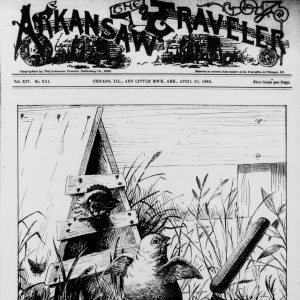calsfoundation@cals.org
Arkansaw Traveler [Newspaper]
In 1882, writer Opie Percival Read and his brother-in-law, Philo Dayton Benham, started the Arkansaw Traveler newspaper in Little Rock (Pulaski County). They published the paper every Saturday, with Read working as editor and Benham managing the business. Read chose to name the paper after the Arkansas Traveler folktale, with the paper masthead including an image of a traveler, sheet music, a squatter, and the squatter’s hut. According to the folktale, which dates back to at least 1840, a lost traveler in rural Arkansas asks a squatter for directions. The squatter is unhelpful until the traveler is able to play the second half of the tune the squatter had begun on his fiddle. Learning the second part of the song makes the squatter so happy that he offers his hospitality and finally gives the traveler directions. Read published this story in the first issue of the Traveler.
Read, who had a droll sense of humor, created the Traveler as a humorous literary paper. The Traveler gained national fame for its humor, especially the character sketches, standing out from other general news and political papers. While paper sales increased, some people took offense at Read’s humor, which painted with broad strokes about life in the South. Eventually, the newspaper lost its popularity as the quality of the writing declined. Read moved to Chicago, Illinois, and in 1887, the Arkansaw Traveler began publishing from Chicago as well as Little Rock.
Read wrote several novels, and in 1888, he started publishing chapters of his novels in weekly installments in the Traveler. Read’s novels included the popular Mrs. Annie Green, Len Gansett, and A Kentucky Colonel. Read left the Traveler in the early 1890s to work on his other literary pursuits. In 1902, the Monticellonian reported that Read was in New York working as a playwright.
In 1896, the Traveler changed to a monthly publication. The last editor recorded for the Arkansaw Traveler was Harry Stephen Keeler, a Chicago native who wrote numerous mystery and science fiction novels. While Keeler published the Arkansaw Traveler, it was listed as a fiction newspaper. By the late 1910s, the Traveler had ceased publication in either city.
Beginning in 2017, the Arkansas Digital Newspaper Project (ADNP) team at the Arkansas State Archives partnered with the Library of Congress as part of the National Digital Newspaper Program (NDNP), funded by grants from the National Endowment for the Humanities (NEH), to digitize historic Arkansas newspapers, including the Arkansaw Traveler.
For additional information:
Allsopp, Frederick W. History of the Arkansas Press for a Hundred Years and More. Little Rock: Parke-Harper Publishing Co., 1922.
The Arkansaw Traveler. Chronicling America: Historic American Newspapers. Library of Congress. https://chroniclingamerica.loc.gov/lccn/sn90050009/ (accessed May 4, 2022).
Biographical and Historical Memoirs of Central Arkansas. Chicago: Goodspeed Publishing Co., 1889.
Dougan, Michael B. Community Diaries: Arkansas Newspapering, 1819-2002. Little Rock: August House Publishing Inc., 2003.
Staff of the Arkansas Digital Newspaper Project
Arkansas State Archives
A version of this entry was initially published on both the website of the Arkansas State Archives and the Library of Congress’s Chronicling America project and is used here with permission.
 Mass Media
Mass Media Post-Reconstruction through the Gilded Age, 1875 through 1900
Post-Reconstruction through the Gilded Age, 1875 through 1900 Arkansaw Traveler
Arkansaw Traveler  Opie Pope Read
Opie Pope Read 



Comments
No comments on this entry yet.